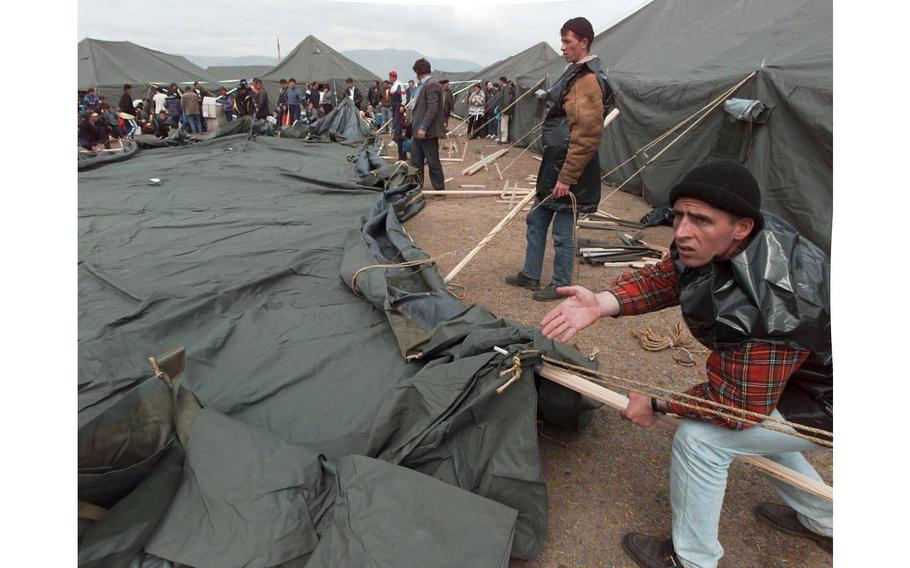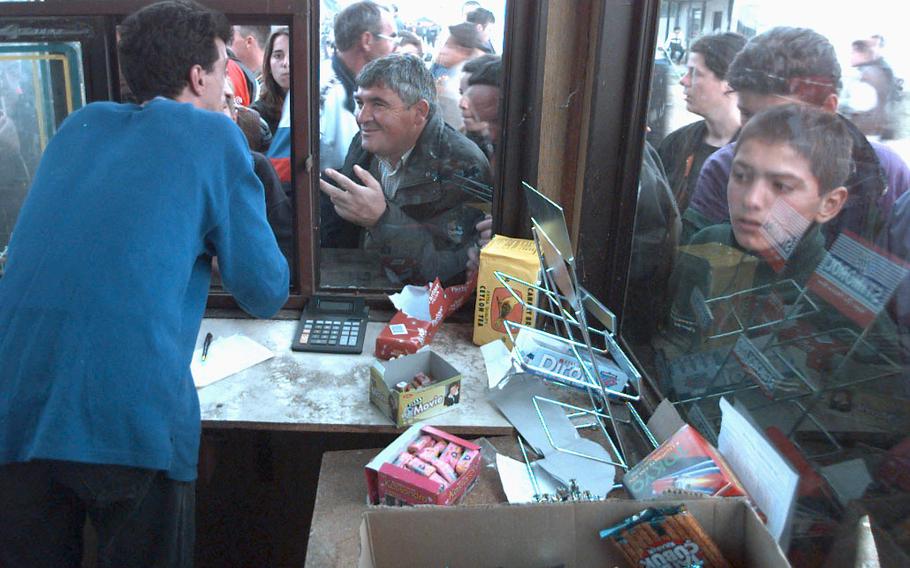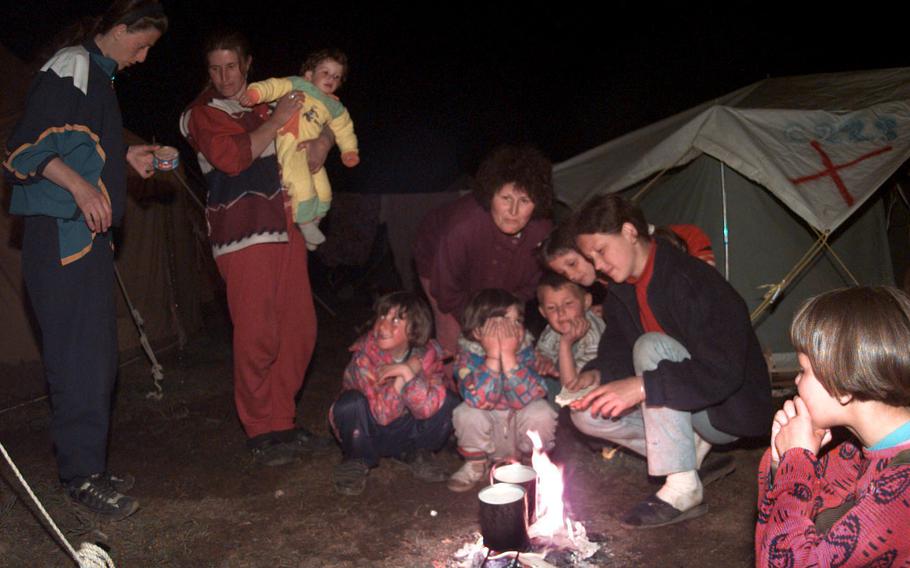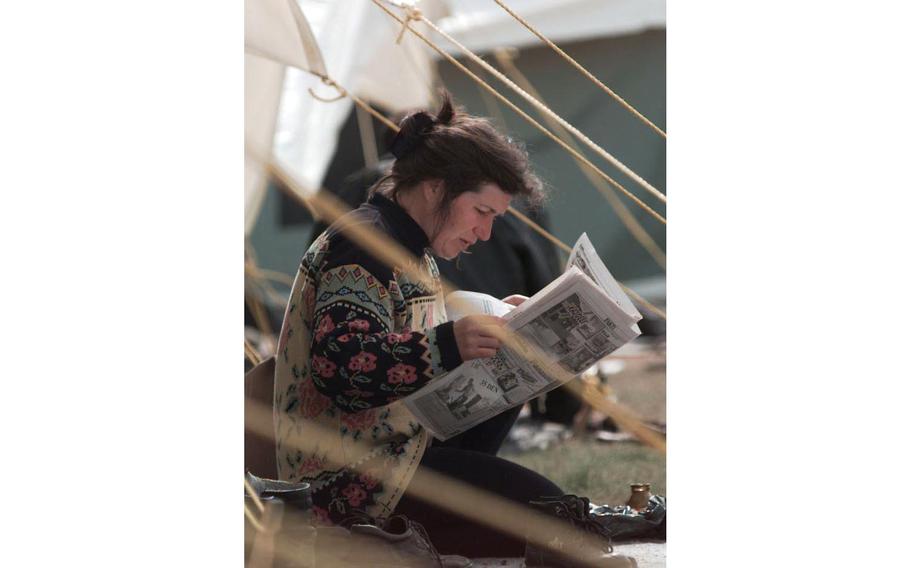
Newly arrived Kosovo refugees put up a tent at the Brazda refugee camp. Scores of refugees are in the background waiting for these gentlemen to erect the tent so that they will have a place to live. (Ron Alvey/Stars and Stripes)
This article first appeared in the Stars and Stripes Europe edition, April 24, 1999. It is republished unedited in its original form.
SKOPJE, Macedonia — At night, the lights of Macedonia’s capital city are clearly visible from the Brazda refugee camp just 15 miles away.
They canvas the landscape in a reminder of a civilization lost to the 27,000-plus ethnic Albanian refugees huddled around small campfires outside of their weather-worn tents. The Kosovars rub their hands over the darting flames, speak in whispers and occasionally find themselves staring over the horizon at the millions of gleaming bulbs that illuminate the distant hills.
But the lights of Skopje might as well be as far away as the stars overhead when viewed through the diamond-shaped wire designs of a metal fence.
“It’s terrible to live here. I would like to go somewhere else,” said Bislim Azemi, who has been in the camp almost two weeks after fleeing his home-in Ferizaj, [Kosovo]. He knows, however, that there’s nowhere else to go for the moment.
“I can’t leave, so I wait, I wait every day. There is nothing else to do,” he said in clear English learned from studying the language in college.
Finding things to do is a common concern for those languishing in the largest of the Macedonian refugee camps as NATO airstrikes continue to pound Serbian territory in an attempt to force a peace agreement and return the displaced Albanians to their homes.

Commerce has set in at the Brazda refugee camp, as stands, selling candy, cigarettes and alcohol have appeared at the camp. (Ron Alvey/Stars and Stripes)
During the day, the Brazda camp is abuzz with U.N. relief activities as food, medicine and personal hygiene necessities are dispensed.
The wide, main dirt paths between the rows of tents generally are clear as aid workers tend to their jobs, but when darkness falls, the congestion becomes almost that of a state fair or carnival as thousands of people walk elbow-to-elbow slowly from one end of the camp to the other and back again.
Some walk just to move around, the activity helping to keep them warmer than lying in their tents and feeling the evening chill seep in. Others walk for the exercise or to scan the faces in the wandering crowd for friends and relatives. It’s not uncommon to hear names called out and see hugs exchanged, followed by small talk, nods, well-wishes and a return to the ambling stream.
Ilymi Bosnjaku’s nightly walk is shorter than most. His pacing takes him 20 yards from his tent and then back. He doesn’t want to go too far from his wife, Sabile lying ill inside. The 49-year-old woman had spent the last five days in a German field clinic because of kidney problems.
“At least they gave her a cot, so she’s not sleeping on the ground,” Bosnjaku said. “We hope to leave in a day or two to England or Germany, where we have sons living.”

Residents of the Brazda refugee camp gather around a fire as nightime settles in. The evening hours seem to magically draw refugees out of their tents and they begin to socialize. (Ron Alvey/Stars and Stripes)
In addition to just walking around, sports are also a popular nightly event, despite the lack of adequate lights or proper equipment.
“Every night we have games,” said one 30-ish-looking man watching a volleyball match being played using an old soccer ball and a stretched-out clothesline. Four stand-alone basketball hoops and a pingpong table near the camp’s center also provide recreation for many older refugees. Younger children, meanwhile, kick around dirty, half-inflated balls to pass the time. Nobody, it seems, wants to go to sleep before they are tired enough not to care that the ground is hard and the air is cold.
A long row of teen-agers lines an old clamshell hangar, once part of the small Stankovic airfield and now used by relief agencies to store supplies. They lean against it and quietly smoke their cigarettes.
Not more than 50 feet away, a small shack operated by an Albanian company in Macedonia has just opened for business. It sells cakes, pretzels, bubble gum, lighters and cigarettes. Cartons and cartons of smokes are stacked inside.
“It’s crazy,” notes one visitor to the camp. “Most of the people here don’t even have any money.”

A lady starts her morning by reading a paper in the Brazda refugee camp in Skopje, Macedonia. (Ron Alvey/Stars and Stripes)
Still, those who do crowd around the booth. Commerce goes on.
Night also is when the refugees find their way to the information boards posted near the camp’s entrance. It’s here that lists of updates are pinned with flight information for the following day: names of those fortunate enough to be put on humanitarian evacuation flights to other countries.
This evening, about 100 names are listed for a flight to Austria and about 75 more for a flight to Sweden.
Next to those postings is one for lost children in the camp — those who arrived without parents. Nearly 100 names are typed on it, but there is nobody waiting here to read this list.
Eventually the small, flickering cigarettes are all smoked, the campfires are burned out and the masses tiredly wander back in the blackness to their own temporary shelters.
And in the distance the lights of civilization continue to shine brightly.
Looking for Stars and Stripes’ coverage of the? Subscribe to Stars and Stripes’ historic newspaper archive! We have digitized our 1948-1999 European and Pacific editions, as well as several of our WWII editions and made them available online through https://starsandstripes.newspaperarchive.com/